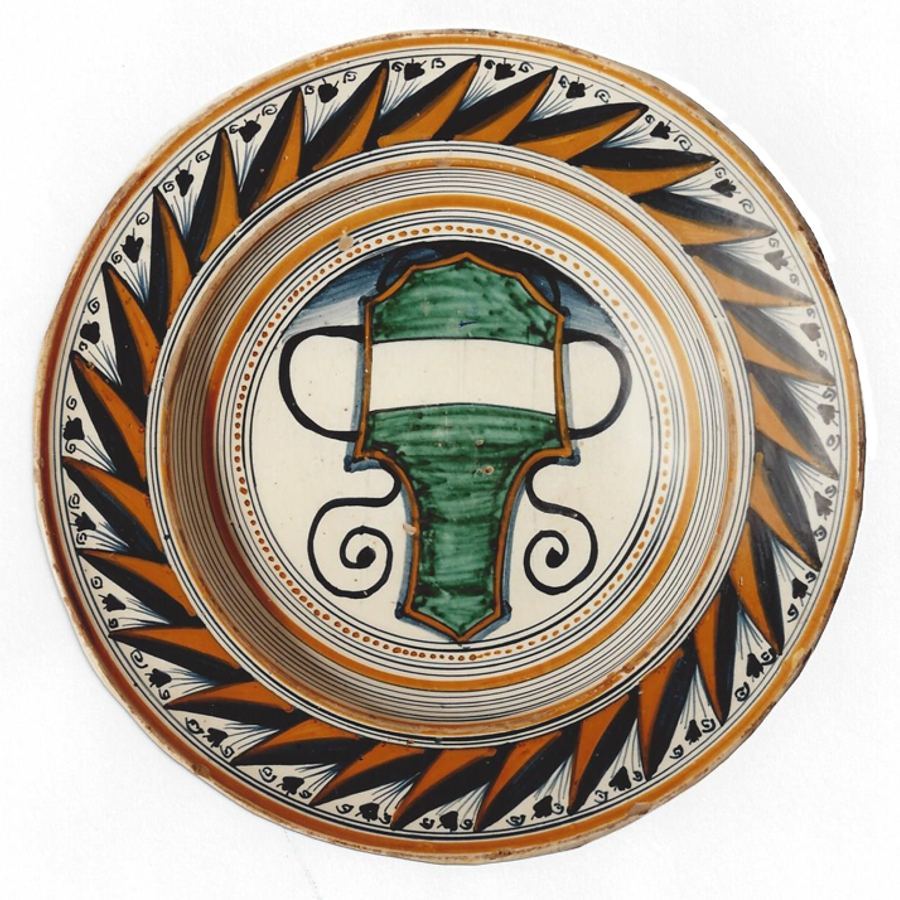
Ankauf des Bayerischen Nationalmuseums, München
Marks
None; collector’s label C.Damiron/ De LyonlCollection/no. 109 XV.
Measurements
37.5 em; 14 1/2 ins.
Condition
Minor chips and wear around the rim; wear to inner rim; loss of glaze to three small plaees in the weIl; large chip to footrim
The large dish (Raekham’s shape no. 2) boldly painted with a large, unidentifiable, coat-of-arms within an ochre line border and showing the colours green and white, all embellished by a blue scrolling ribbon and shown whithin concentric lines in yellow and blue and oehre dots.
The slightly everted rim decorated with a radiating band of stiff leaves in blue and oehre and alternating with stylised flower; lead-glazed back.
Provenance
Alfred Pringsheim Colleetion, Munich
Charles Damiron Collection, Lyon
Private Collection, New York
Literature
See O.v.Falke, Die Majolika Sammllung Alfred Plingsheim, 2 vols., The Hague 1914 and 1923, and the Sotheby’s Sale Catalogue. London June/July 1939, lot. 50.
For other examples witb similar decoration to the border see a later plate in the Louvre colleetion, Dr.J.Chompret, Les majoligues italienne, 1940, vol.II, p.32, fig.239; another, which is attributed to Florenee 1450170, see the A.v.Beekerath sale Catalogue, Lepke Berlin, Nov.l913, pl. 27, no. 46 (with similar border but geometric/foliate eentral design); see also the Mortimer Schiff collection Catalogue, New York 1927, nO.16.
For Raekham’ s shapes of maiolica dishes see B.Rackham, Italian Maiolica in the Victoria and Albert Museum, London 1977, vol.l. Appendix, p.456 and 457.
The Deruta factory was founded by Cesare Borgia in the second half of the 15th century – according to E.Molinier. However, there is according to W.B: Honey, record of Deruta potters already in 1387. It is interesting to note that Cesare Borgia was educated in the neighbouring Perugia and became Archbishop ofValencia in 1492. Valencia was by then already famous for their lustre wares which had been imported into Italy throughout the 15th century. Deruta specialised in imitating these lustre wares from around 1~00 – very possibly on the initiation of the Archbishop.
The pieces of highest quality were made in Deruta during 1490-1530.
Several signed and dated pieces from Deruta are recorded between 1515-1554. The earlier pieces can only be dated by comparative conclusions.
Collecting Italian maiolica of the 15th century was first and foremost discovered by Wilhelm von Bode in Berlin, Adolf von Beckerath and Alfred Pringsheim in Munich during the late 19th and early 20th century. When these collections were sold during the first half of the 20th century the following collectors continued this tradition: Robert Lehmann, whose collection is now in the Metropolitan Museum in New Y ork: Charles Damiron, now mostly dispersed,see the sale Catalogue, Sotheby’ s London, 16.6.1938: Dr. Back, see the sale Catalogue, Sotheby’ s
London, 7.12.1965; Mr. Adda, see the sale Catalogue, C.Humphrey’s, London 1967. For an extensive discourse on the history of the Alfred Pringsheim collection and the collecting of 15th century Italian maiolica see Timothy Wilson’s foreword to the third volune of the ltalian Maiolica of the Plingsheim Collection. Ferrara, 1994, pp.43.
